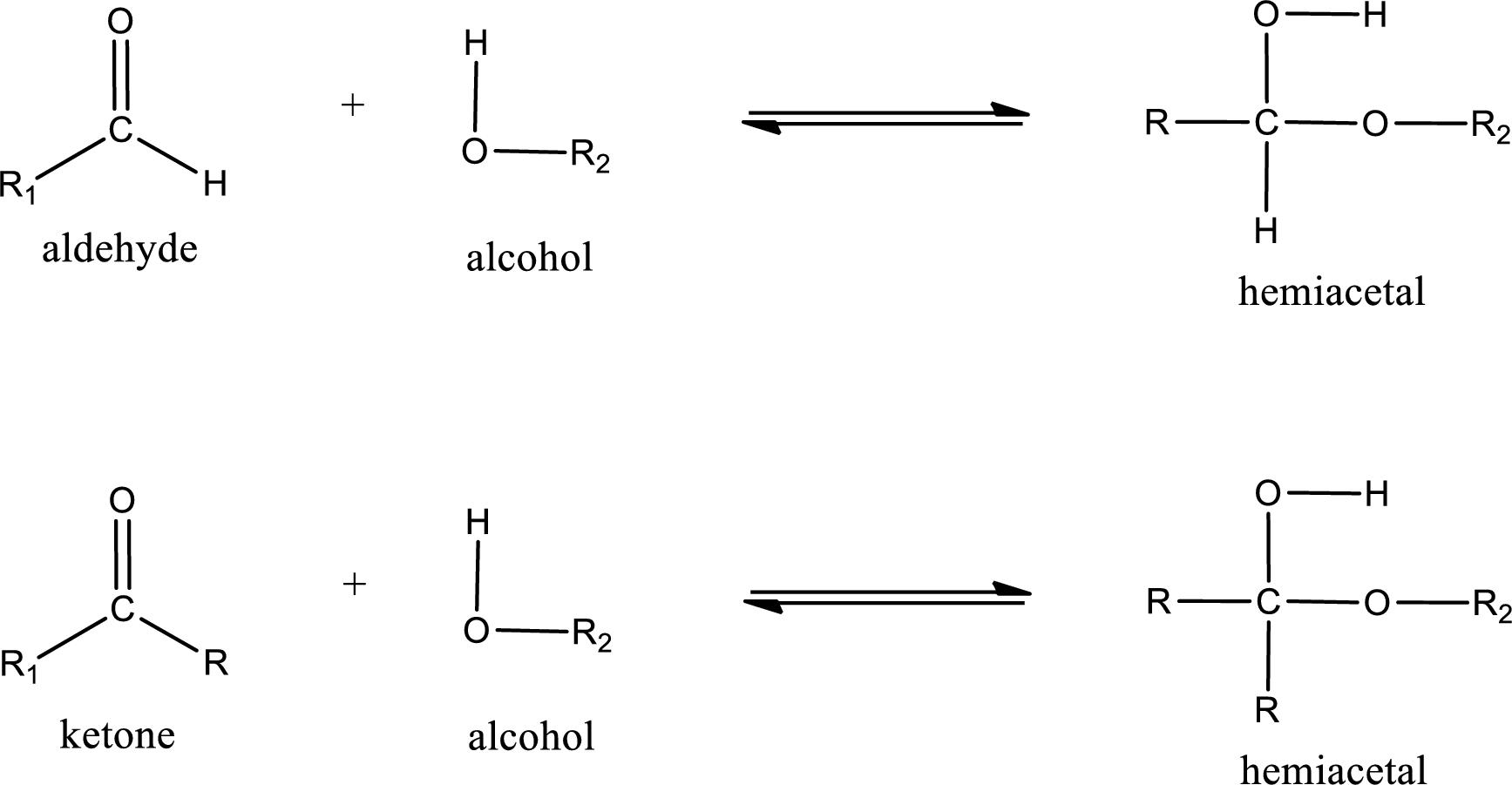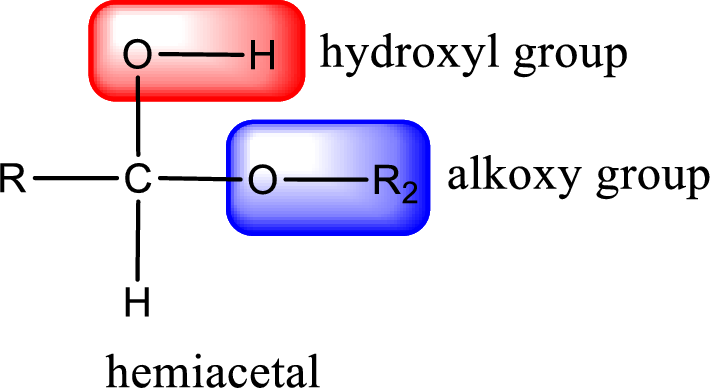
(a)
Interpretation:
Condensed structural formula of the organic product that is formed when 3-pentanone is treated with hydrogen in presence of nickel catalyst has to be given.
Concept Introduction:
In
In organic chemistry, reduction reaction is referred to the number
Alcohols undergo oxidation reaction and reduction reaction. This depends upon the number of hydrogen atoms that is bonded to the alpha carbon atom. Primary and secondary alcohol undergoes oxidation reaction while tertiary alcohol does not undergo oxidation reaction. Primary alcohols undergo oxidation to give
Aldehyde undergoes oxidation to give carboxylic acid as the product while ketone does not undergo oxidation reaction.
The reverse of
(b)
Interpretation:
Condensed structural formula of the organic product that is formed when 3-pentanone is treated with methanol in 1 to 1 reacting ratio has to be given.
Concept Introduction:
Aldehydes contain a carbonyl group that is bonded to a hydrogen atom and a carbon atom. Ketones are compounds that contain a carbonyl group bonded to two carbon atoms. Aldehydes and ketones undergo addition reaction across the carbonyl group.
Aldehydes and ketones react with alcohol to form hemiacetal as the product. This reacts with further molecule of aldehyde or ketone to form acetal.
Hemiacetal is an addition product that is obtained by reaction between aldehyde or ketone with alcohol. The general reaction of hemiacetal formation can be given as,

(c)
Interpretation:
Condensed structural formula of the organic product that is formed when 3-pentanone is treated with ethanol in 1 to 2 reacting ratio has to be given.
Concept Introduction:
Aldehydes contain a carbonyl group that is bonded to a hydrogen atom and a carbon atom. Ketones are compounds that contain a carbonyl group bonded to two carbon atoms. Aldehydes and ketones undergo addition reaction across the carbonyl group.
Aldehydes and ketones react with alcohol to form hemiacetal as the product. This reacts with further molecule of aldehyde or ketone to form acetal.
Hemiacetal is an addition product that is obtained by reaction between aldehyde or ketone with alcohol. The general reaction of hemiacetal formation can be given as,

From the above general structure of hemiacetal it is found that it is an organic compound that contains a carbon atom that is bonded to an alkoxy group and a hydroxyl group.

Acetal is formed when the formed hemiacetal reacts with further alcohol molecule so that the hydroxyl group in the hemiacetal is converted into alkoxy group. This can be shown as given below,

The alcohol that is reacting with the hemiacetal can be from the same alcohol which involved in formation of hemiacetal or a different alcohol molecule. Therefore, the ketone or aldehyde must react with two alcohol molecules that may or may not be identical to form acetal.
(d)
Interpretation:
Condensed structural formula of the organic product that is formed when 3-pentanone is treated with
Concept Introduction:
In organic chemistry, oxidation reaction is referred to the number
In organic chemistry, reduction reaction is referred to the number
Alcohols undergo oxidation reaction and reduction reaction. This depends upon the number of hydrogen atoms that is bonded to the alpha carbon atom. Primary and secondary alcohol undergoes oxidation reaction while tertiary alcohol does not undergo oxidation reaction. Primary alcohols undergo oxidation to give aldehyde and carboxylic acid as product. Secondary alcohol undergoes oxidation to give ketone as the product.
Aldehyde undergoes oxidation to give carboxylic acid as the product while ketone does not undergo oxidation reaction.
Trending nowThis is a popular solution!

Chapter 4 Solutions
Organic And Biological Chemistry
- List the following compounds in order of increasing water solubility: a.ethoxyethane b.propanoic acid c.pentane d.1 butanolarrow_forward1. Give the reaction of linoelic acid that reacts with sulfuric acid 2. Give the reagent and the reaction conditions that would distinguish between the following compounds. Write equations for the reactions involved. -2-methylpentane and 2-methyl-2-pentenearrow_forwardQ1 Aldehydes contain the carbonyl group bonded to at least one hydrogen atom. contain the carbonyl group bonded to two carbon atoms contain the carbonyl group bonded to three carbon atoms Q2 compounds with the general formula R S. R′, where R and R′ are hydrocarbon radicals. These compounds can be considered as analogs of ethers, generated by replacing the oxygen atom with sulfu. Organic sulfides C16H32 C16H34 Q3 CH3 CH2 OH 1)Ethyl alcohol 2)2- methyl propanol 3)propyl Q5 The boiling point increase with increasing carbon number , and they usually decrease with branching . 1)Alcohols 2)Ethers 3)Di ethyl ether Q4 The first three primary alcohols soluble in water 1)T 2)F Q6 organic compounds which incorporate a carbonyl functional group, C=O. 1)Aldehydes and ketones 2)Phenol 3)alcohols Q7 Crude oil 1)is a mixture of hydrocarbons 2)Option 2 3)Option 3 Q8 types of hydrocarbon compounds present in crude oil 1)paraffins 2)naphthenes 3)ALL ITQ11 The hydrogen…arrow_forward
- Which substances can react with potassium borohydride, converting the product into alkene alcohol (assuming complete reaction)?arrow_forwardTrue or false The hydroxyl group found in an organic compound is responsible for its basicity. Aromatic hydrocarbons are considered polar and has high affinity to water. Acidic drugs are a class of chemical compounds that normally have high hydrophilicity and negative charges. Amino groups attached to hydrocarbons are considered polar which may be responsible for its solubility. Lipophilic drugs have a faster rate of absorption than hydrophilic drugs.arrow_forward1.Give the common name of 2,2-dimethyl-1-propanethiol and give the complete equation as the compound is exposed to oxidation. 2.What will be the product of the compound in #1 if added with NaOH?arrow_forward
- Purification of Organic Compounds What type of organic compounds can be purified by distillation?arrow_forward1a) All of the following would be considered isomers of each other except for which compound? Why? a) 2,2-dimethylpropane b) 2-methylbutane c) 3-methylbutane d) pentane e)2,3-dimethylbutane 1b)Which of the following pairs are considered isomers?Why? a) 1-propene and 1-propyne b)ethyl propanoate and hexanoic acid c)ethyl methyl ether and 1-butanol d) hexanoic acid and 2 pentanol e) ethyl hexyl and 2-octanolarrow_forwardWhat are the structures of cyclohexanone and salicylaldehyde substances constitutes? i) Is it saturated or unsaturated or aromatic amine or phenol? ii) Aromatic or Aliphatic in nature? iii) What is their functional group? (aldehyde/ketones/esters)arrow_forward
- WHich of the following uses of ethers is not correct a. diethyl ether is used as a propellant for aerosol sprays b. ethers are used as an inert solvent c. solutes for varnishes and lacquers d. ethers used as cooling agentarrow_forwardWhat structural characteristic is shared by the aldehydes and the ketones? A) They both are straight chain compounds. B) Aldehydes and ketones both contain a carbonyl carbon. C) Both of these compound classes have as the smallest compound a 5 carbon skeleton. D) Aldehydes and ketones have no shared characteristics.arrow_forwardComplete the following chemical reactions. Make sure to draw and name all structural formulae for all organic compounds (both reactants and products). a. Oxidation of 2-pentanol. (K2Cr2O7/H+) → b. Formic acid + Isopropyl alcohol (2-propanol) → c. Acetic acid + Propylamine → d. Dehydration of 2,3-dimethyl-1-butanol (H+/heat) →arrow_forward
 Organic And Biological ChemistryChemistryISBN:9781305081079Author:STOKER, H. Stephen (howard Stephen)Publisher:Cengage Learning,
Organic And Biological ChemistryChemistryISBN:9781305081079Author:STOKER, H. Stephen (howard Stephen)Publisher:Cengage Learning, General, Organic, and Biological ChemistryChemistryISBN:9781285853918Author:H. Stephen StokerPublisher:Cengage Learning
General, Organic, and Biological ChemistryChemistryISBN:9781285853918Author:H. Stephen StokerPublisher:Cengage Learning Chemistry for Today: General, Organic, and Bioche...ChemistryISBN:9781305960060Author:Spencer L. Seager, Michael R. Slabaugh, Maren S. HansenPublisher:Cengage Learning
Chemistry for Today: General, Organic, and Bioche...ChemistryISBN:9781305960060Author:Spencer L. Seager, Michael R. Slabaugh, Maren S. HansenPublisher:Cengage Learning Chemistry: The Molecular ScienceChemistryISBN:9781285199047Author:John W. Moore, Conrad L. StanitskiPublisher:Cengage Learning
Chemistry: The Molecular ScienceChemistryISBN:9781285199047Author:John W. Moore, Conrad L. StanitskiPublisher:Cengage Learning Chemistry & Chemical ReactivityChemistryISBN:9781133949640Author:John C. Kotz, Paul M. Treichel, John Townsend, David TreichelPublisher:Cengage Learning
Chemistry & Chemical ReactivityChemistryISBN:9781133949640Author:John C. Kotz, Paul M. Treichel, John Townsend, David TreichelPublisher:Cengage Learning




